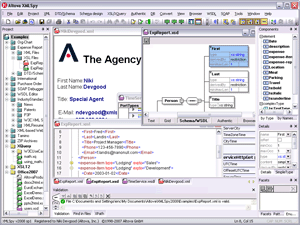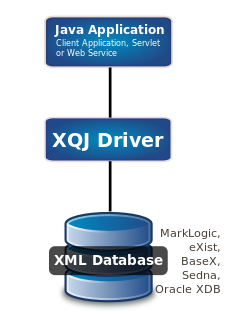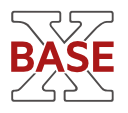XSLT is a language originally designed for transforming XML documents into other XML documents, or other formats such as HTML for web pages, plain text or XSL Formatting Objects, which may subsequently be converted to other formats, such as PDF, PostScript and PNG. Support for JSON and plain-text transformation was added in later updates to the XSLT 1.0 specification.

Db2 is a family of data management products, including database servers, developed by IBM. They initially supported the relational model, but were extended to support object–relational features and non-relational structures like JSON and XML. The brand name was originally styled as DB/2, then DB2 until 2017 and finally changed to its present form.
XForms is an XML format used for collecting inputs from web forms. XForms was designed to be the next generation of HTML / XHTML forms, but is generic enough that it can also be used in a standalone manner or with presentation languages other than XHTML to describe a user interface and a set of common data manipulation tasks.
Query languages, data query languages or database query languages (DQLs) are computer languages used to make queries in databases and information systems. A well known example is the Structured Query Language (SQL).
eXist-db is an open source software project for NoSQL databases built on XML technology. It is classified as both a NoSQL document-oriented database system and a native XML database. Unlike most relational database management systems (RDBMS) and NoSQL databases, eXist-db provides XQuery and XSLT as its query and application programming languages.
An XML database is a data persistence software system that allows data to be specified, and sometimes stored, in XML format. This data can be queried, transformed, exported and returned to a calling system. XML databases are a flavor of document-oriented databases which are in turn a category of NoSQL database.

XMLSpy is a proprietary XML editor and integrated development environment (IDE) developed by Altova. XMLSpy allows developers to create XML-based and Web services applications using technologies such as XML, JSON, XBRL, XML Schema, XSLT, XPath, XQuery, WSDL and SOAP.
XQuery Update Facility is an extension to the XML Query language, XQuery. It provides expressions that can be used to make changes to instances of the XQuery 1.0 and XPath 2.0 Data Model.
XPath is an expression language designed to support the query or transformation of XML documents. It was defined by the World Wide Web Consortium (W3C) and can be used to compute values from the content of an XML document. Support for XPath exists in applications that support XML, such as web browsers, and many programming languages.
In software development XRX is a web application architecture based on XForms, REST and XQuery. XRX applications store data on both the web client and on the web server in XML format and do not require a translation between data formats. XRX is considered a simple and elegant application architecture due to the minimal number of translations needed to transport data between client and server systems. The XRX architecture is also tightly coupled to W3C standards to ensure XRX applications will be robust in the future. Because XRX applications leverage modern declarative languages on the client and functional languages on the server they are designed to empower non-developers who are not familiar with traditional imperative languages such as JavaScript, Java or .Net.

MarkLogic Server is a document-oriented database developed by MarkLogic. It is a NoSQL multi-model database that evolved from an XML database to natively store JSON documents and RDF triples, the data model for semantics. MarkLogic is designed to be a data hub for operational and analytical data.
XQuery is a query and functional programming language that queries and transforms collections of structured and unstructured data, usually in the form of XML, text and with vendor-specific extensions for other data formats. The language is developed by the XML Query working group of the W3C. The work is closely coordinated with the development of XSLT by the XSL Working Group; the two groups share responsibility for XPath, which is a subset of XQuery.
Sedna is an open-source database management system that provides native storage for XML data. The distinctive design decisions employed in Sedna are (i) schema-based clustering storage strategy for XML data and (ii) memory management based on layered address space.

XQuery API for Java (XQJ) refers to the common Java API for the W3C XQuery 1.0 specification.

BaseX is a native and light-weight XML database management system and XQuery processor, developed as a community project on GitHub. It is specialized in storing, querying, and visualizing large XML documents and collections. BaseX is platform-independent and distributed under the BSD-3-Clause license.

Elasticsearch is a search engine based on the Lucene library. It provides a distributed, multitenant-capable full-text search engine with an HTTP web interface and schema-free JSON documents. Elasticsearch is developed in Java and is dual-licensed under the source-available Server Side Public License and the Elastic license, while other parts fall under the proprietary (source-available) Elastic License. Official clients are available in Java, .NET (C#), PHP, Python, Ruby and many other languages. According to the DB-Engines ranking, Elasticsearch is the most popular enterprise search engine.
Zorba is an open source query processor written in C++, implementing
Stylus Studio is an integrated development environment (IDE) for the Extensible Markup Language (XML). It consists of a variety of tools and visual designers to edit and transform XML documents and legacy data such as electronic data interchange (EDI), comma-separated values (CSV) and relational data.
JSONiq is a query and functional programming language that is designed to declaratively query and transform collections of hierarchical and heterogeneous data in format of JSON, XML, as well as unstructured, textual data.





